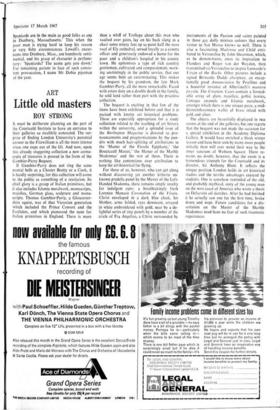Little old masters
ART ROY STRONG
It must be deliberate planning on the part of the Courtauld Institute to have an entrance to their galleries so stealthily concealed. The sur- prise of finding London University's potential answer to the Fitzwilliam is all the more intense when one steps out of the lift. And now, upon this already staggering collection a new cornu- copia of treasures is poured in the form of the Gambier-Parry Bequest.
If Gambier-Parry does not ring the same mental bells as a Chester Beatty or a Cook, it is hardly surprising, for this collection will come to the public as something of a revelation. Its chief glory is a group of Italian primitives, but it also includes Islamic metalwork, manuscripts, majolica, German glass, sculpture and manu- scripts. Thomas Gambier-Parry, a Gloucester- shire squire, was of that Victorian generation which included the Prince Consort and the Eastlakes, and which pioneered the taste for Italian primitives in England. There is more than a whiff of Trollope about this man who vaulted over gates, lay on his back slung in a chair some ninety feet up to paint half the nave roof of Ely cathedral, served loyally as a county officer and generously endowed a home for the poor and a children's hospital in his county town. He epitomises a type of rich country gentleman, cultivated and compassionate, work- ing unstintingly in the public service, that our age seems bent on exterminating. This makes the bequest by his grandson, the late Mark Gambier-Parry, all the more remarkable. Faced with estate duty on a double death in the family, he sold land rather than part with the priceless collection.
The bequest is exciting in that few of the items have been exhibited before and that it is packed with knotty art historical problems. These are especially appropriate for a study collection related to the teaching of art history within the university, and a splendid issue of the Burlington Magazine is devoted to pro- nouncements and prognostications by the pun- dits with much hair-splitting of attributions to the 'Master of the Fiesole Epiphany,' the Boucicault Master,' the Master of the Marble Madonnas' and the rest of them. There is nothing like contentions over attribution to keep the art-historical fur flying.
For those of us, however, who can get along without discovering yet another hitherto un- known predella panel by the Master of the Left- Handed Madonna, there remains simple revelry for indulgent eyes: a breathtakingly fresh Lorenzo Monaco Coronation of the Virgin, Christ enveloped in a dark blue cloak, his Mother, arms folded, eyes downcast, arrayed in white embroidered with gold; near by a de- lightful series of tiny panels by a member of the circle of Fra Angelico, a Christ surrounded by instruments of the Passion and saints painted in those gay dolly mixture colours that every visitor to San Marco knows so well. There is also a fascinating Madonna and Child attri- buted to Verrocchio by John Shearman, which, as he demonstrates, owes its inspiration to Flanders and Roger van der Weyden, then transmitted via Verrocchio to inspire Leonardo's Virgin of the Rocks. Other pictures include a signed Bernardo Daddi altarpiece, an excep- tionally good Annunciation by Pesellino and a beautiful instance of Albertinelli's maniera piccola, The Creation. Cases contain a formid- able array of glass, majolica, gothic ivories, Limoges enamels and Islamic metalwork, amongst which there is one unique piece, a mid- thirteenth-century wallet of brass inlaid with gold and silver.
The objects are beautifully displayed in two rooms at the end of the galleries, but one regrets that the bequest was not made the occasion for a special exhibition in the Academy Diploma Gallery. It would have enriched a bleak winter season and have been seen by many more people initially than will ever wend their way to the inner sanctum of Woburn Square. There re- mains no doubt, however, that the event is a tremendous triumph for the Courtauld and its director, Sir Anthony Blunt. It reflects the unique position London holds in art historical studies and the terrific advantages enjoyed by students. One is somehow reminded of the old, and probably mythical, story of the young man on the west coast of America who wrote a thesis on Delacroix oil sketches. After he had finished it he actually saw one for the first time, broke down and wept. Future candidates for a dis- sertation on the Master of the Marble Madonnas need have no fear of such traumatic experiences.






























 Previous page
Previous page